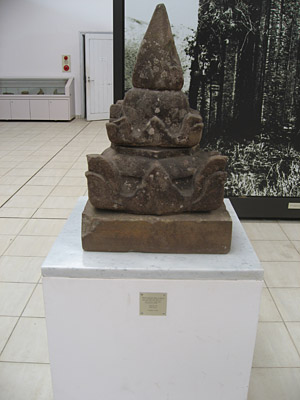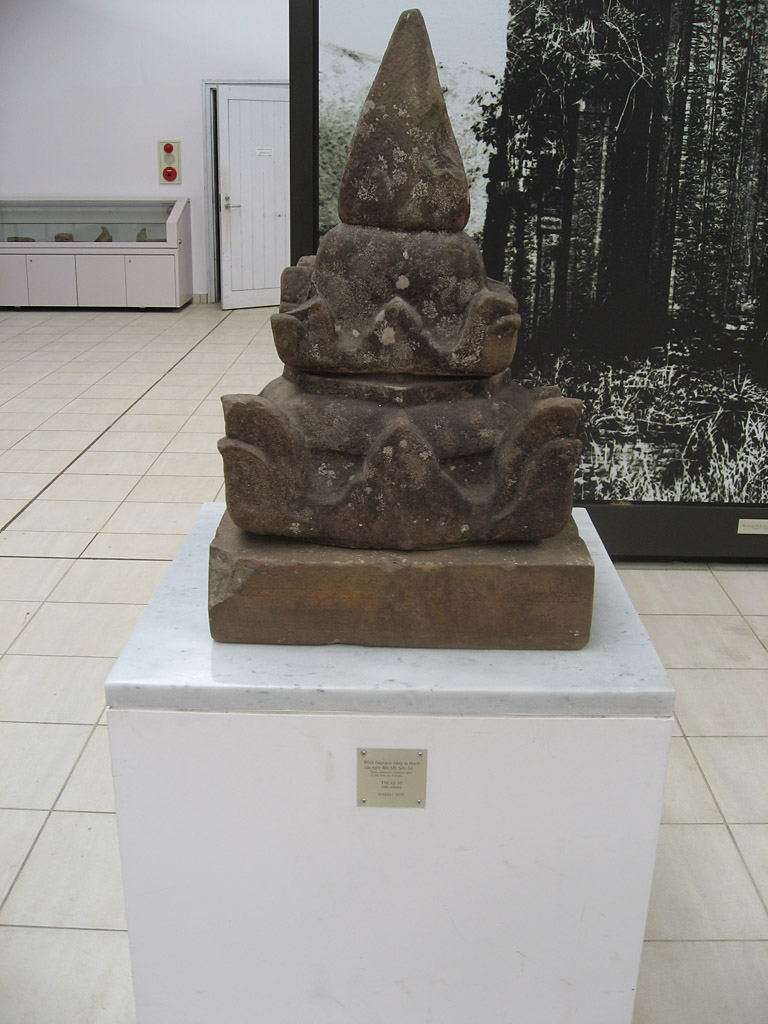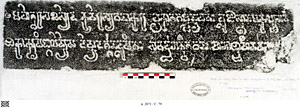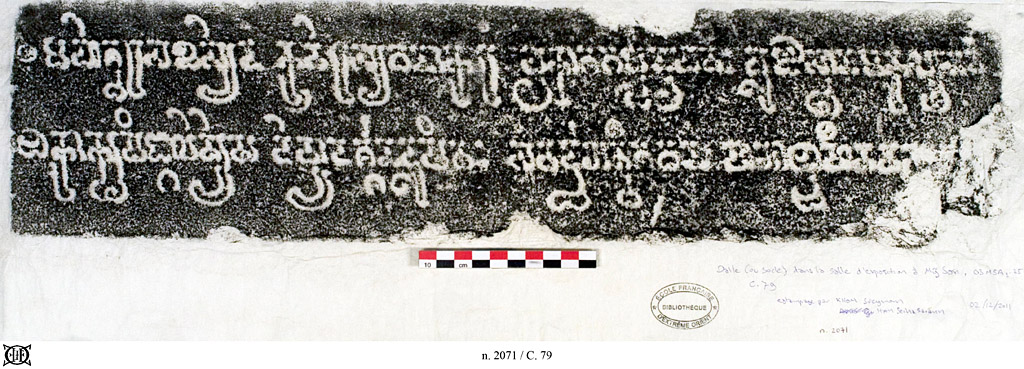Corpus of the Inscriptions of Campā




C. 79 Pedestal at Mỹ Sơn
Please note: you are reviewing a preprint version of this publication. Contents here may change significantly in future versions. Scholars with specific interests are urged to consult all cited bibliography before using our texts and translations or drawing other significant conclusions.
Support Low pedestal; sandstone; we have not recorded dimensions, but Finot 1904d: 928 has recorded the following: h. 14 cm × w. 58 × d. 58.
Text Two lines on one face written in Sanskrit.
Date 6th century Śaka (7th CE).
Origin Site of Mỹ Sơn (Quảng Nam).
The stone was found at Mỹ Sơn, on or near the steps of A10 before 1904, and was listed as number V in the list of inscriptions of this site (Finot 1904d: 928; see also the table in that article; and Parmentier 1909: 357).1 We identified the stone in the Mỹ Sơn site museum in 2009, as the one bearing local inventory number 03MSA1.252 (see ECIC III: 458).
Edition(s) First published, with French translation, in Finot 1904d: 928; whence, with significantly improved translation into English, in Majumdar 1927: 27; whence Golzio 2004: 9-10. Re-edited from the inked EFEO estampage, with new translation, in ECIC V: 421-423, whence the present edition.
Facsimiles
- Estampage: EFEO 336
- Estampage: EFEO n. 2071
The following text was edited by Dominic Goodall and Arlo Griffiths.
IIb darśśanadūṣitaḥ ◇ darśanadūṣitaḥ Finot. In conformity with his general practice, Finot here applies silent normalization. — IId || ◇ (vac.) Finot.
Translations
English
I. The king Prakāśadharman has fashioned [this] place of worship, a mine of riches, for Maheśvara's (i.e. Śiva's) companion Kubera.
II. Spoiled in [one] eye by the goddess, [such that he became known] as Ekākṣapiṅgala, may he cause the property of the Lord to increase, and may he always protect from what is untoward (ahitataḥ).
French
We cite Finot's translation of 1904:
Ce sanctuaire du compagnon de Maheśvara, Kuvera, mine de richesses, le roi Prakāśadharma l'a édifié. Si quelqu'un est affligé d'une maladie d'yeux par la déesse Ekākṣapiṅgalā (la rousse borgne), qu'il augmente les richesses du Seigneur, et (celui-ci) le défendra du mal à jamais.
Commentary
Notes
- There is an inconsistency between these three references with regard to the exact provenance. The first reports “trouvé sur les marches de A10”, the second “près des marches de A10”, and the third “au perron de A10”.
- Recorded under this number in the registration of Mỹ Sơn as a Unesco World Heritage Site



An early version of the myth of Kubera's companionship of Śiva is recounted in the old Skandapurāṇa, at 29.169 (see Bakker & Isaacson 2004).
Finot understood ekākṣapiṅgalety as ekākṣapiṅgalā ity and noted that the (feminine) evil spirit Ekākṣapiṅgalā was not known to him from any other source. As was seen by Majumdar, it has to be understood as ekākṣapiṅgala ity, and so the name in question is (masculine) Ekākṣapiṅgala, which is a name of Kubera, e.g. in the Himavatkhaṇḍa (19.4). He appears as Ekākṣipiṅgala in the old Skandapurāṇa (29.149). That is also the form of the name in Rāmāyaṇa 7.13:24,30-31, which perhaps gives the earliest known version of the myth. For Vettam Mani's version of the myth, see Mani 1975, § 13, s.v. Kubera. The sandhi is a bit unusual, but parallels can nevertheless be cited: the Cambodian inscription K. 524, st. I, begins with vidyāvāseti nāmāhaṁ tejasvī bhuvi viśrutaḥ (IC III, p. 134); the second half of Harivaṁśa 12.16: yathotpannas tathaivāhaṁ kumāra iti viddhi mām | tasmāt sanatkumāreti nāmaitan me pratiṣṭhitam ||. Our interpretation of the two modal verbs in the second stanza as both being predicates to a single subject (eṣa) disagrees with Finot's, following instead Majumdar's. The latter scholar has still misunderstood the significance of darśanadūṣita, for based on the myth to which allusion is made here, this must clearly mean an impairment at the eye (of Kubera), rather than by the eye (of the Goddess).
By contrast with Majumdar, who translates “the wealth of this king”, we consider it likely that īśadhana here denotes primarly the wealth of Śiva (devadravya) endowed to his temple, and that a subsidiary shrine to Kubera was installed near it for protective purposes.